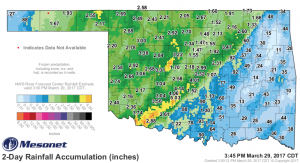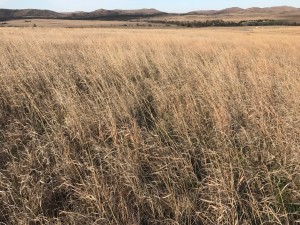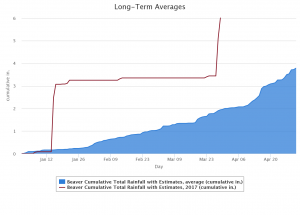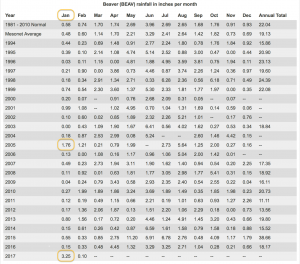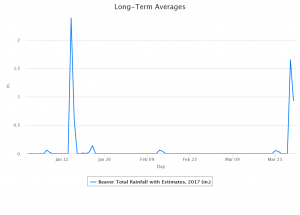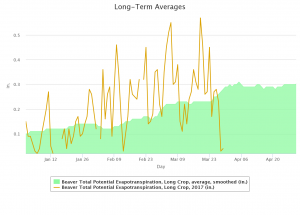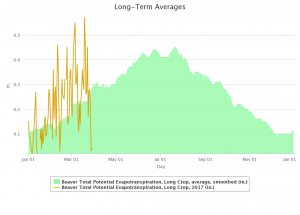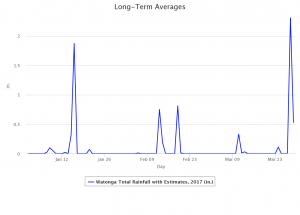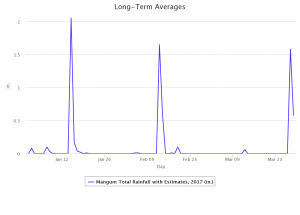Western Oklahoma’s latest rain was critical to the success of this year’s winter wheat and canola crops. It also brought much needed relief to fire fighters as it drenched areas where large, devastating fires occurred in early March. The rain came with storms on March 28-29, 2017.
If we just looked at rainfall totals, we’d be hard pressed to believe that 2017 is dealing with “dry” year conditions. That’s because rainfall totals since January 1st fail to tell the story of real-world conditions. One has to drill down and scrutinize rainfall totals under the microscope of daily rainfall events and amounts. And the Oklahoma Mesonet has just the tool to do that, the Mesonet Long-Term Averages Graph maker.
Beaver, Oklahoma is now known nationally due to the devastating fires that burned nearby in early March. Those fires burned hundreds of thousands of acres, the majority of that on the first two days of the blazes. The fires started where there was dense, extremely dry, fine fuels and were driven by 50 mile per hour winds.
(Dead, standing tall native grasses. Photo taken March 23, 2017 at Wichita National Wildlife Refuge.)
The intensity and speed of the fires confirmed the dryness of the dead native grasses that covered Beaver County. Yet the total precipitation at Beaver, since January 15th has consistently been above its 15-year long-term average. Even before rain on March 28th, Beaver had a 2017 rainfall accumulation of 3.44 inches. Beaver’s long-term average doesn’t go above that amount until April 27th.
January 2017 with 3.25 inches was the wettest January at Beaver since Mesonet became operational in January 1994. Only one other January since 1994 collected more than an inch of rain, 2005 with 1.76 inches.
(Mesonet Rainfall by Month Table)
So why didn’t the rainfall total better match “real world” conditions at Beaver this year? What has made 2017 unique is how much moisture was collected from the two precipitation events, how much time passed between rain events, and how magnified were the drying conditions.
At Beaver there has only been two precipitation events so far this year. A rain and ice storm on January 15th that delivered 2.39 inches of water and 1.65 inches of rain on March 28th. Between those events 49 days passed with no significant rainfall.
One way to monitor the intensity of drying conditions is to look at potential evapotranspiration rates. Potential evapotranspiration is a calculated estimate of water evaporation from the soil surface and water lost through plants in inches per day. When plant material is dead, we can use potential evapotranspiration as an index of drying conditions. The higher the index is above normal the dryer the conditions. When the index is below average, dead plant material drys very slowly or is taking up moisture.
During the 49 days between rain events at Beaver, the potential evapotranspiration rates were way above normal. On March 5th, the day before the fires, the tall crop potential evapotranspiration for 2017 was 0.51 inches, yellow line. Even back on February 10th, the tall crop evapotranspiration was 0.46 inches. The 15-year average (2002-2016) for that date is 0.13 inches, green fill.
In fact, some peak potential evapotranspiration rates this February and March were more typical of those in June and July. When weather varies greatly from normal, it sets up conditions for bad things to happen, freezes, floods, fires, or drought. In Beaver County this March, it was destructive fires.
How did Beaver compare to some other places? Watonga is in the center of Oklahoma’s main winter wheat production area that stretches from Grandfield to Guymon, west of I-35. Watonga had two good rain events in February, 0.75 inches on February 13th and 0.81 inches on February 19th, that bypassed Beaver.
In southwest Oklahoma, Mangum also had one good additional rain on February 13th, 1.65 inches compared with Beaver. Mangum’s rain in February came at a good time. It split the 49 days between events in January and March.
The Long-Term Averages graph and map makers are excellent tools to better understand weather’s role on Oklahoma’s environment and ecosystem impacts. Graphing weather data can help you drill down to the critical weather drivers.
